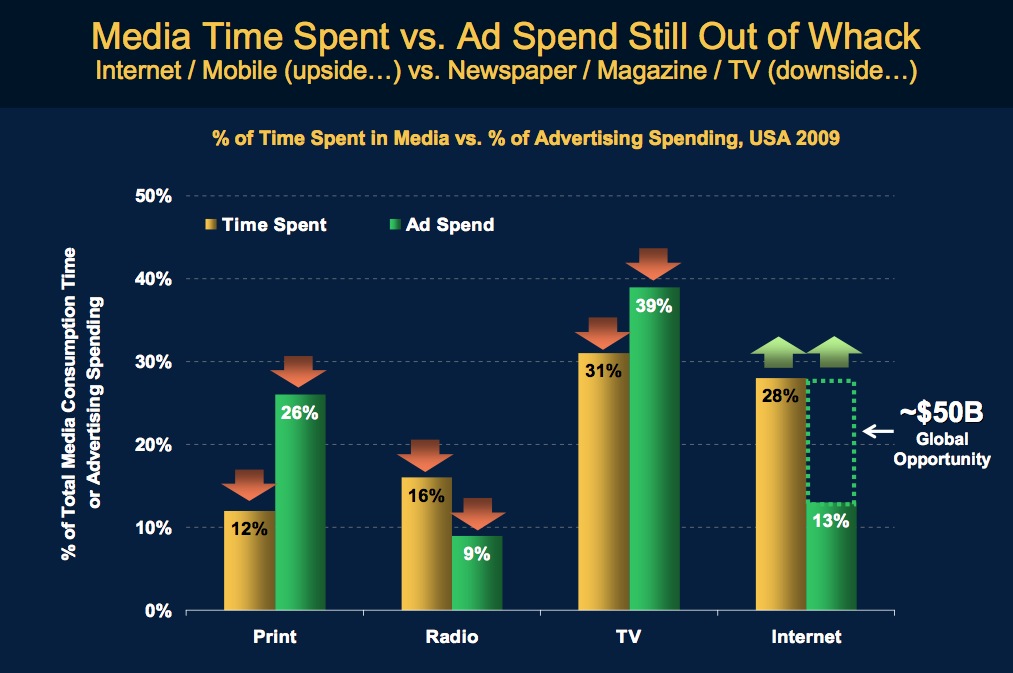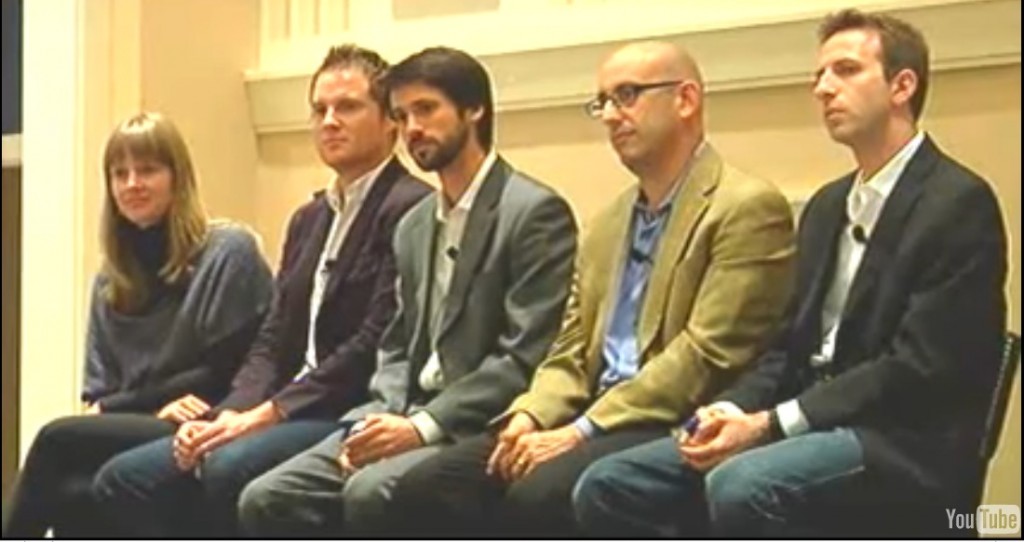9 Futurists Give 2020 Digital World Predictions to Mashable
July 11, 2012

9 Futurists give Mashable's Amy-Mae Elliott predictions for the digital future. Image courtesy of S58y. Used under Creative Commons license, http://creativecommons.org/licenses/by/2.0/deed.en.
We’re always interested in predictions for the future and were excited to be asked by Mashable’s Amy-Mae Elliott for one of our own in her article “9 Bold Predictions for the Digital World of 2020.” Dr. John Vanston chimed in on how voice quality by 2020 will be so excellent that “Younger generations will hear something that theretofore only older generations remember: the sound of a pin dropping.”
A couple of the futurists’ comments in the Mashable article refer to the massive amounts of information that is increasingly available to everyone. According to Dave Evans, Cisco Chief Futurist, “We are amassing unprecedented amounts of data – a zettabyte alone this year. This data is social and public (Facebook, Twitter, YouTube, blogs, etc.). Billions of devices (25-50 billion by 2020) will contribute exponentially to this avalanche of data … By 2015, Cisco Visual Networking Index predicts 1 million video minutes will traverse the Internet every second.”
According to Brian David Johnson, Futurist, Intel, “the size of the meaningful computational power keeps getting smaller and smaller. So, as we approach 2020 the size of the intelligent gets closer to zero in size, nearly invisible.”
Those that can use these massive amounts of information most imaginatively will have a very real advantage in the coming years. A good way to winnow through the information is finding minitrends in your areas of interest within the larger emerging trends. We talk extensively about this on this site and in our MINITRENDS book. Also stay tuned for our formal announcement of MINITRENDS 2012: A Conference on Translating Emerging Trends Into Business Opportunities scheduled October 17-18 at the Omni Downtown in Austin.
We are also intrigued by futurist Mike Walsh comments about virtual avatars: “By 2020 retail virtual avatars – on screens and in holographic projection – will start to become popular.” Perhaps, these virtual avatars will be waiting on us in the not too distant future!
We talk about Virtual Worlds being a minitrends opportunity in MINITRENDS. For the free excerpt from the book, see “Expanding Involvement in Virtual Worlds.”
Cheers,
Carrie
What is Social CRM? Major New Tech Trend Takes Hold
February 15, 2011
 If you haven’t heard about “Social CRM” yet, get ready. Predictions are this will be the “technology trend of the year” for 2011.
If you haven’t heard about “Social CRM” yet, get ready. Predictions are this will be the “technology trend of the year” for 2011.
Simply stated, Social CRM is the marriage of your Rolodex with Twitter. The Rolodex represents your Customer Relationship Management system, or CRM: your database of contacts, clients, prospects, employees, customers, or anyone else your organization keeps tabs on. Twitter represents the social side of these contacts, whether they express themselves on Twitter, Facebook, LinkedIn, through comments on blogs, or other ways online.
When you merge your CRM system with social networking, what you get is an amazing lifecycle understanding of how your customers were influenced to contact you, what they purchased once they did, and how those purchases worked out for them. Imagine being able to ask a customer, “How did you find out about us” and “How is that purchase working out for you” without having to ask — and being able to rely on the answers as honest and real. That’s the power of Social CRM.
Social CRM begins when an organization starts to listen to what people are saying about it online, and posts its own messages through social media such as Twitter and Facebook. Social CRM deepens when organizations go beyond watching themselves to watching their customers, employees, and other contacts. According to CRM expert and Inc. magazine reporter, Brent Leary, “2011 looks to be shaping up as the year companies go beyond focusing on marketing and promotion” with Social CRM.
Leary is on the board of the Customer Relationship Management Association and editor of its newsletter, “Insights.” His article for Inc. magazine reviews a conference on Social CRM at the University of Toronto held at the end of last year. The conference was the inaugural event for the new Center for CRM Excellence at the University’s Rotman School of Management. Leary debriefs several experts on Social CRM including Greg Gianforte at RightNow, Marcel LeBrun at Radian6, Alex Bard at Assistly, and John Bastone at SAS.
Social networking gives organizations the opportunity to eavesdrop on contacts as they reveal their opinions through actions and comments online. Social CRM gathers those tidbits of information and combines them into reports about contacts that are far more elaborate than professional profilers ever could have imagined. Social CRM makes it possible to, among other things, fix a customer’s problem before they even know they have a problem, or before they report it. That’s powerful marketing!
Another excellent article comes from Maria Ogneva at Mashable, a site not known for deep articles. Ogneva has an interest in the subject, as the director of social media for Nimble, a social relationship management firm. Still, Ogneva intelligently lays out the fundamentals of Social CRM:
The social customer may go to Twitter with a question, a user forum with a customer service query, Facebook with a compliment, or Yelp with a complaint. The processes you establish will largely determine your ability to respond quickly and with the relevant information, while uniting all of these interactions under one customer record.
If you think Social CRM is just another fad that will soon disappear, maybe Gartner will persuade you otherwise? In a study released this week, the giant IT research firm predicted that Social CRM sales will exceed $1 billion by 2013. Spending on Social CRM is expected to double this year, from 4% to 8% of total CRM spending.
Chris DiMarco, Web Editor for TMCnet, nails the significance of Gartner’s report when he writes, “The utility to include and target individuals based on information they’ve provided voluntarily on social media sites will likely be necessary to compete in the very near future.” In short, if you don’t get Social CRM, you don’t get the customer. And that’s the simple reason Social CRM is shaping up to be the app of the year for 2011.
STEVE O’KEEFE
News Editor, Minitrends Blog
Source: “2011: The Year Social CRM Goes Mainstream,” Inc., December 27, 2010
Source: “Why Your Company Needs to Embrace Social CRM,” Mashable, May 21, 2010
Source: “Gartner Says Spending on Social Software to Support Sales, Marketing and Customer Service Processes Will Exceed $1 Billion Worldwide By 2013,” Gartner news release, February 8, 2011
Source: “Social CRM to Explode in the Immediate Future says Gartner Study,” TMCnet, February 8, 2011
Image by nerissa’s ring, used under its Creative Commons license.
Trend of the Year: Social Shopping
November 29, 2010
 In case you hadn’t noticed, this Thanksgiving marked the tipping point of a major new technology trend: Social Shopping. When you combine the spread of social networking, the market penetration of mobile phones, the desperation of retailers to capture more business, and consumers’ love of the deal, you wind up with Social Shopping.
In case you hadn’t noticed, this Thanksgiving marked the tipping point of a major new technology trend: Social Shopping. When you combine the spread of social networking, the market penetration of mobile phones, the desperation of retailers to capture more business, and consumers’ love of the deal, you wind up with Social Shopping.
Richard MacManus, the founder and CEO of ReadWriteWeb, which is consistently one of the best blogs covering Internet technology trends, recently kicked off a series looking back on the top tech trends of 2010. He begins the series by looking at Social Shopping.
In 2010, we’ve seen the rise of so-called ‘social shopping’ services. They rely heavily on technologies such as social networking, crowdsourcing and smart phone scanners. Here we present five of the main social shopping developments of 2010.
MacManus doesn’t just pick five companies to profile, but five different types of Social Shopping technologies. Who knew there were so many? Here are his top picks, along with examples of companies that have been using these technologies to attract consumers:
1. Daily Deals: Companies that send one or more “deal of the day” messages to subscribers. Examples: Groupon, LivingSocial.
2. Real-Time Shopping: These deep discounts might last for only a few minutes or hours or until supplies run out. Example: Woot.
3. Location Check-In Services: These services offer rewards to people who check in frequently or on certain days. Examples: Foursquare, Yelp.
4. Facebook Shopping: MacManus credits Facebook with enabling Social Shopping through deals with Amazon.com and other retailers.
5. Barcode Scanning: Phone apps that allow you to take a picture of a barcode or QR code with your phone, then search for reviews, deals, or other information on the Internet. Examples: RedLaser, ScanLife.
Last week, we wrote about how Google CEO Eric Schmidt revealed a new feature for Android phones that will allow you to skip the barcode photo and just wave your phone near an NFC chip to learn about deals on a product.
If those aren’t enough leads for you to explore the new world of Social Shopping, then take a look at Mashable’s list of 18 Sites for Social Shopping — and don’t forget to look in the comments for another 18 or so!
Happy Holidays!
STEVE O’KEEFE
News Editor, Minitrends Blog
Source: “Top Trends of 2010: Social Shopping,” ReadWriteWeb, 11/15/10
Source: “SHOPPING SPREE: 18 Sites for Social Shopping & Deals,” Mashable, 08/08/07
Photo by Jenelle/Thriving Ink, used under its Creative Commons license.
Meeker’s Top Internet Trends: Online Advertising Undervalued
November 17, 2010

Mary Meeker runs the global technology research team as a managing director of investment giant, Morgan Stanley. When Meeker talks, the market listens, and she was saying plenty at the recent Web 2.0 summit in San Francisco.
On Tuesday, November 16, Meeker shared her picks for the top Internet trends, backed up with some of the most cleverly crafted stats I’ve ever seen. Among the revelations: Print publications occupy only 12% of the amount of time consumers spend with media, yet account for 26% of advertising spending. This does not bode well for the future of advertiser-supported print media.
On the other hand, Meeker’s stats show that the Internet takes up 28% of people’s time for media, yet draws only 13% of advertisers’ budgets. She says there’s $50 billion too little being spent in online advertising.
Mashable’s Ben Parr summarized Meeker’s misallocation thusly: Facebook is “the most under-monitized asset in online advertising.” According to Meeker’s stats, social networking is earning a mere 55 cents per thousand impressions (CPM) from advertisers. Compare this to CPM’s of about $2.70 for the majority of websites that accept display advertising. Also grossly undervalued, according to Meeker, are display ads embedded in email, which earn only 89 cents CPM.
Parr was modest enough not to mention that Mashable ranked as one of the Top 10 brands on Twitter, coming in at position number 10 — right behind the National Basketball Association (NBA) and just ahead of Martha Stewart.
Another slide in Meeker’s presentation compared the number of people who “like” brands on Facebook with the number of viewers for popular television programs — and the CPMs associated with those TV shows. Zynga’s Texas Hold’em Poker leads the likes on Facebook with 27.2 million, which is roughly equivalent to the number of American Idol viewers. Whereas display ads on Facebook cost a mere $0.55 per thousand impressions, American Idol charges $30. We profiled Zynga founder Mark Pincus here on the Minitrends blog last month, where he talked about the importance of good eating habits.
Some of the other trends mentioned in the book, MINITRENDS, which also caught Mary Meeker’s eye, include the growth of virtual worlds. Meeker favorably compared the Japanese social networking site, Tencent (637 million active users), with Facebook (620 million annual visitors). The difference? Tencent is a virtual world using avatars. The shocking stat that caught my attention: over $1.4 billion in virtual goods have been sold on Tencent! Those are real yen shelled out for virtual merchandise such as outfits for avatars.
Another shocking stat: Seven of the top 15 Internet companies by market capitalization in 2004 are not in the top 15 today. Punishment is swift for those who do not stay on the edge of innovation. Case in point: Nokia and RIM held 70% of the smartphone market as recently as 2008. Today, that market share has dropped to 52% while Google (Android) and Apple (iPhone) have gone from nothing to gobbling up 42% of the market.
Despite a Morgan Stanley copyright notice, Mary Meeker’s slideshow seems to be everywhere online. You can find it at Mashable and TechCrunch, along with some very cursory commentary.
STEVE O’KEEFE
News Editor, Minitrends Blog
Source: “The Unprecedented Rise of Apple iOS and Other Internet Trends,” Mashable, 11/16/10
Source: “Mary Meeker On Ten Questions Internet Execs Should Ask And Answer,” TechCrunch, 11/16/10
Image from Morgan Stanley, used under Fair Use: Commentary.
Blackbaud Videos Reveal Trends in Nonprofit Technology
November 15, 2010

CLICK FOR VIDEO: Panel on Social Media for Nonprofits from the 2010 Blackbaud Conference on Nonprofit Technology
Last week, I broached the topic of how nonprofits are capitalizing on trends in technology to reach constituents through social networking. Today, I’m going to take the discussion up a notch and look at the fountainhead of many tech trends for nonprofits: Blackbaud, Inc.
Blackbaud was founded in 1981 with the purpose of providing technological support to nonprofit organizations. The company’s growth since has been phenomenal. Headquartered in Charleston, South Carolina, Blackbaud now employs more than 2,000 people worldwide. The company went public in 2004 and is traded on the NASDAQ exchange under ticker symbol BLKB.
Shortly after going public, Blackbaud hired Marc Chardon, a former CFO for Microsoft and manager of Microsoft France, as the company’s new president and CEO. Just last week, Blackbaud was named one of Forbes 100 Best Small Companies in America, a ranking based largely on exceptional financial performance.
Blackbaud has become an enormous driver of technology trends in the nonprofit sector. Last month, the company held its annual conference on nonprofit technology, drawing more than 2,200 people to Washington, D.C., for an action-packed program dominated by seminars on social networking.
This month, Blackbaud has made many of these programs available for free viewing on its BlackbaudTV channel on YouTube. These videos are both inspiring and educational for anyone interested in technology trends. Here are some of the highlights:
Global Trends and What They Mean to You
Marc Chardon, President and CEO of Blackbaud
Becoming a Networked Nonprofit: The Road to Effective Use of Social Media
Allison Fine & Beth Kanter, authors of The Networked Nonprofit
Social Media for Nonprofits
Claire Williams Diaz, Social Innovation at Twitter
Noah Everett, Founder of TwitPic
Matthew Mahan, Vice President of Impact at Causes
Geoff Livingston, Co-Founder of Zoetica
Brian Dresher, Mashable (formerly with USA Today)
Social Media: Paint by the Numbers
Holly Ross, Executive Director, NTEN: The Nonprofit Technology Network
The Nonprofit Trust Agent
Chris Brogan, New York Times bestselling co-author of Trust Agents
Most of the videos are an hour long, except for the Chris Brogan interview, which is a five-minute ambush video in the hallway of the conference center. The first video with Marc Chardon is a panel that covers such trends as social media, radical transparency, and the need for nonprofits to demonstrate ROI. The panel on social media for nonprofits is terrific, with presenters limited to five minutes to take their best shots, followed by the audience Q&A.
For access to all the BlackbaudTV videos — including a five-minute interview with Mark Zuckerberg’s engaging and articulate sister, Randi, about five things nonprofits can do to supercharge their Facebook pages — visit the BlackbaudTV page on YouTube.
STEVE O’KEEFE
News Editor, Minitrends Blog
Source: “Blackbaud Conference 2010: 5 Must-See Presentations,” Social Media 4 Nonprofits, 10/24/10
Source: “Reflections from Independent Sector and Blackbaud Conferences,” Beth’s Blog, 10/26/10.
Nonprofits Take Social Networking to New Heights
November 12, 2010
 Social networking is a megatrend that has been gaining momentum since bulletin boards first made it possible for people to schmooze online in the 1980s. Out of this megatrend have come numerous Minitrends that investors have profitably mined over the past five years, including social bookmarking, tagging, and location-based networks such as Foursquare.
Social networking is a megatrend that has been gaining momentum since bulletin boards first made it possible for people to schmooze online in the 1980s. Out of this megatrend have come numerous Minitrends that investors have profitably mined over the past five years, including social bookmarking, tagging, and location-based networks such as Foursquare.
Steve Monfort, a writer for NASDAQ.com, recently reported on the growing trend of small businesses hiring more people to handle social media:
A recent American Express survey shows that 40 percent of small businesses are using social networking to promote their offerings, up from 10 percent a year ago.
While small businesses are just warming-up to social networking, nonprofit organizations were among the earliest to embrace the trend. By now, everyone has heard about “text-to-give,” which was used by the American Red Cross to collect $30 million from cellphone users for earthquake relief in Haiti last year. According to nonprofit tech guru Tonia Zampieri, sales and marketing manager for LoyaltyClicks, a division of Smart Online, text-to-give is so 2009.
Smart Online recently conducted a survey into technology trends for nonprofit organizations. The results were reported on NTEN, the Nonprofit Technology Network, just a few days ago. They indicate that over 90% of nonprofits actively use social networking (compared with only 40% of small businesses, according to American Express). The breakdown: 91% use Facebook, 63% use Twitter, 45% use YouTube, and 35% use LinkedIn.
You would think that level of penetration would be cheered by the nonprofit experts at LoyaltyClicks. But Zampieri has found a weakness in charity tech: mobile myopia. She writes:
[O]nly 16% of the surveyed nonprofits plan on having mobile websites in 2011, while 19% plan on having smartphone applications.
Zampieri cites a Nielson study that almost one-quarter of the time people are online is spent using social networks — and that half of that social networking is done with mobile devices. Then she provides “compelling reasons why a mobile website or a mobile application might work better for your organization” than, for example, old-fashioned text-to-give:
- donations aren’t limited to $5 or $10
- donations are received immediately
- you capture and control crucial data about your donors
- any size charity can use this technology, not just giants
- it’s a permanent tool, not just a one-shot appeal
For inspiring examples about the way nonprofit organizations are innovating with social networking, we recommend a recent Mashable story on “5 Must-Follow Non-Profits Making a Difference With Social Media.” The article is a run-up to the annual Mashable Awards which will be held January 6, 2011, at the Consumer Electronics Show (CES) in Las Vegas.
I was particularly impressed by the way the Brooklyn Museum has made use of a wide variety of social networking Minitrends to engage visitors and benefactors both online and in person. The museum has a dedicated mobile site (LoyaltyClicks would approve) that allows browsers to tag the museum’s 94,000 piece collection, making it easier for visitors to locate must-see art based on other patrons’ comments. They also use Foursquare to provide restaurant suggestions and other ideas to fill out a trip to the museum.
If you have any other examples of nonprofits who are making innovative uses of social networking applications, we’d like to hear about them. And so would Mashable! The Mashable Awards are open for nomination until November 29.
STEVE O’KEEFE
News Editor, Minitrends Blog
Source: “Job growth anticipated in cloud computing, apps, social media,” NASDAQ.com News, 10/15/10
Source: “Technology Trends for Nonprofits in 2011,” NTEN, the Nonprofit Technology Network, 11/08/10
Source: “5 Must-Follow Non-Profits Making a Difference With Social Media,” Mashable, 11/06/10
Image courtesy of Lisa Brewster, used under its Creative Commons license.


